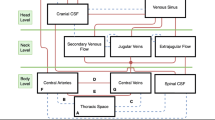Abstract
The ability of an air sac placed in the intrancranial fluid spaces to absorb pressure pulses across the brain has been demonstrated by means of a mechanical model of the cranial cavity.
A two-fold pressure reduction occurred when 20 ml of air at atmospheric pressure was placed in the cranial cavity (simulated). A progressive decrease in effectiveness with increasing volume was noted, 50 ml being the effective maximum value.
Sommaire
On a démontré à l'aide d'un modèle mécanique de la cavité crânienne qu'un sac d'air situé dans les espaces du fluide intercrânien est capable d'absorber les pulsations de pression sur tout le cerveau. Une réduction de moitié de la pression fut observée lorsque 20 ml d'air à la pression atmosphérique était introduit dans la cavité crânienne (simulation). Une diminution progressive de l'efficacité fut notée avec l'augmentation du volume, l'efficacité maximum étant située à 50 ml.
Zusammenfassung
An einem mechanischen Modell des Hirnhohlraums wurde gezeigt, inwiefern ein Luftsack, der in die im Innern des Schädels gelegenen, mit Flüssigkeit ausgefüllten Räume eingesetzt nachdem 20 ml Luft mit atmosphärischem Druck in den kranialen Hohlraum (simuliert) gegeben wurden. Bei wachsendem Volumen war eine progressive Abnahme in der Leistungsfähigkeit zu verzeichnen, wobei 50 ml den effektiven Maximalwert darstellten.
Similar content being viewed by others
Abbreviations
- D :
-
Et 3/12(1−σ2)
- E :
-
Young's modulus
- h :
-
deflection
- K T :
-
bulk modulus at constant temperature
- m :
-
mass
- P :
-
pressure
- r :
-
radius
- t :
-
diaphragm thickness
- T :
-
temperature
- v :
-
volume
- w :
-
load per unit area
- γ:
-
ratio of specific heats
- ρ:
-
density (=m/v)
- σ:
-
Poisson's ratio
- a :
-
atmospheric
- c :
-
critical
- f :
-
final
- i :
-
injected
- r :
-
resting
References
Lewer Allen, K. (1971) A study of the pressure of the cerebrospinal fluid in man by remote monitoring through the skull. CSIR Symposium on Biotelemetry, Pretoria.
Morley, A. (1943)Strength of materials. Longmans, 9th edn., 459.
Author information
Authors and Affiliations
Rights and permissions
About this article
Cite this article
Bunt, E.A., Pastoll, G., Smoleniec, J. et al. Measurement of the effect of an enclosed volume of air on the compressibility of a simulated cranial cavity. Med. & biol. Engng. 14, 316–320 (1976). https://doi.org/10.1007/BF02478128
Received:
Accepted:
Issue Date:
DOI: https://doi.org/10.1007/BF02478128




